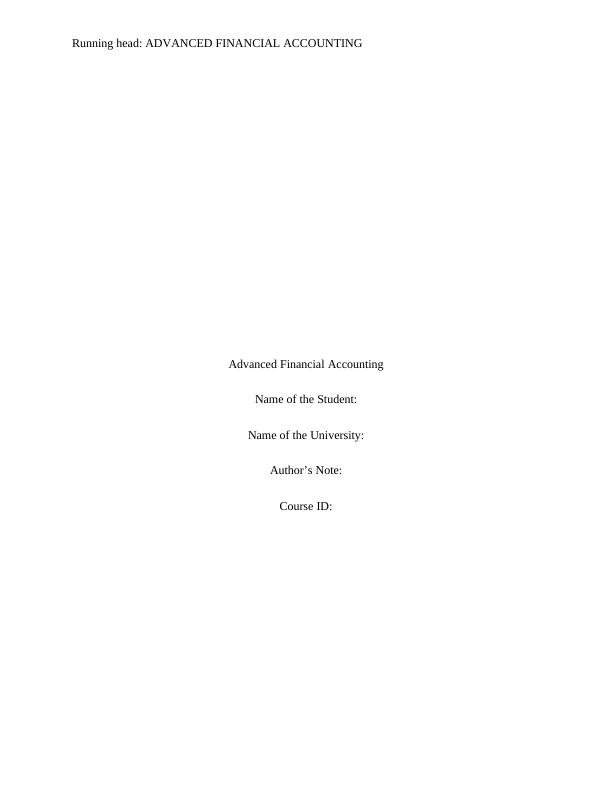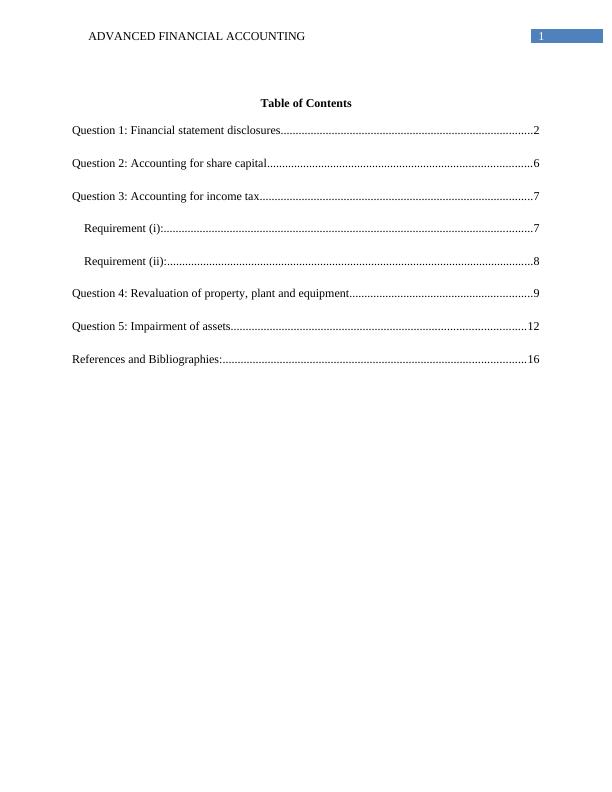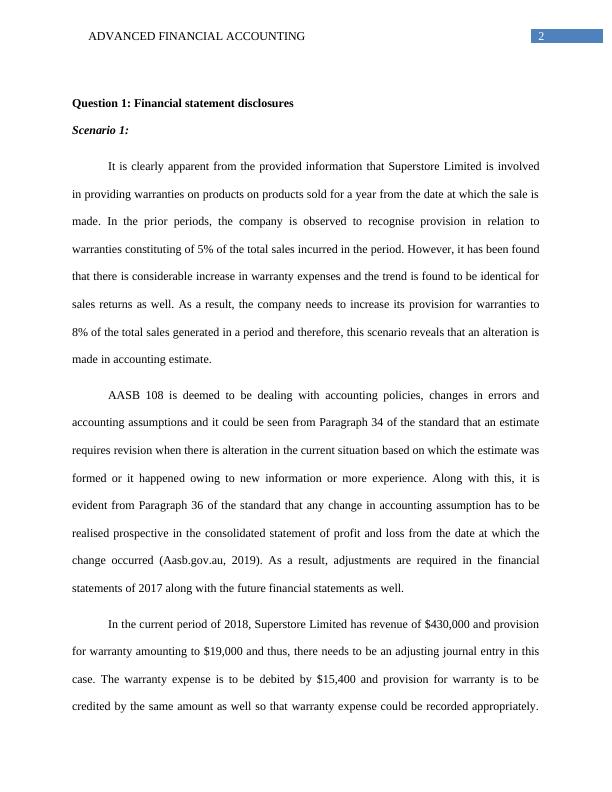Advanced Financial Accounting
Added on 2023-03-23
18 Pages2229 Words61 Views
Running head: ADVANCED FINANCIAL ACCOUNTING
Advanced Financial Accounting
Name of the Student:
Name of the University:
Author’s Note:
Course ID:
Advanced Financial Accounting
Name of the Student:
Name of the University:
Author’s Note:
Course ID:

1ADVANCED FINANCIAL ACCOUNTING
Table of Contents
Question 1: Financial statement disclosures....................................................................................2
Question 2: Accounting for share capital........................................................................................6
Question 3: Accounting for income tax...........................................................................................7
Requirement (i):...........................................................................................................................7
Requirement (ii):..........................................................................................................................8
Question 4: Revaluation of property, plant and equipment.............................................................9
Question 5: Impairment of assets..................................................................................................12
References and Bibliographies:.....................................................................................................16
Table of Contents
Question 1: Financial statement disclosures....................................................................................2
Question 2: Accounting for share capital........................................................................................6
Question 3: Accounting for income tax...........................................................................................7
Requirement (i):...........................................................................................................................7
Requirement (ii):..........................................................................................................................8
Question 4: Revaluation of property, plant and equipment.............................................................9
Question 5: Impairment of assets..................................................................................................12
References and Bibliographies:.....................................................................................................16

2ADVANCED FINANCIAL ACCOUNTING
Question 1: Financial statement disclosures
Scenario 1:
It is clearly apparent from the provided information that Superstore Limited is involved
in providing warranties on products on products sold for a year from the date at which the sale is
made. In the prior periods, the company is observed to recognise provision in relation to
warranties constituting of 5% of the total sales incurred in the period. However, it has been found
that there is considerable increase in warranty expenses and the trend is found to be identical for
sales returns as well. As a result, the company needs to increase its provision for warranties to
8% of the total sales generated in a period and therefore, this scenario reveals that an alteration is
made in accounting estimate.
AASB 108 is deemed to be dealing with accounting policies, changes in errors and
accounting assumptions and it could be seen from Paragraph 34 of the standard that an estimate
requires revision when there is alteration in the current situation based on which the estimate was
formed or it happened owing to new information or more experience. Along with this, it is
evident from Paragraph 36 of the standard that any change in accounting assumption has to be
realised prospective in the consolidated statement of profit and loss from the date at which the
change occurred (Aasb.gov.au, 2019). As a result, adjustments are required in the financial
statements of 2017 along with the future financial statements as well.
In the current period of 2018, Superstore Limited has revenue of $430,000 and provision
for warranty amounting to $19,000 and thus, there needs to be an adjusting journal entry in this
case. The warranty expense is to be debited by $15,400 and provision for warranty is to be
credited by the same amount as well so that warranty expense could be recorded appropriately.
Question 1: Financial statement disclosures
Scenario 1:
It is clearly apparent from the provided information that Superstore Limited is involved
in providing warranties on products on products sold for a year from the date at which the sale is
made. In the prior periods, the company is observed to recognise provision in relation to
warranties constituting of 5% of the total sales incurred in the period. However, it has been found
that there is considerable increase in warranty expenses and the trend is found to be identical for
sales returns as well. As a result, the company needs to increase its provision for warranties to
8% of the total sales generated in a period and therefore, this scenario reveals that an alteration is
made in accounting estimate.
AASB 108 is deemed to be dealing with accounting policies, changes in errors and
accounting assumptions and it could be seen from Paragraph 34 of the standard that an estimate
requires revision when there is alteration in the current situation based on which the estimate was
formed or it happened owing to new information or more experience. Along with this, it is
evident from Paragraph 36 of the standard that any change in accounting assumption has to be
realised prospective in the consolidated statement of profit and loss from the date at which the
change occurred (Aasb.gov.au, 2019). As a result, adjustments are required in the financial
statements of 2017 along with the future financial statements as well.
In the current period of 2018, Superstore Limited has revenue of $430,000 and provision
for warranty amounting to $19,000 and thus, there needs to be an adjusting journal entry in this
case. The warranty expense is to be debited by $15,400 and provision for warranty is to be
credited by the same amount as well so that warranty expense could be recorded appropriately.

3ADVANCED FINANCIAL ACCOUNTING
The current provision to be made would be 8% of sales, which is $34,400 ($430,000 x 8%) from
which the provision already made of $19,000 has to be deducted resulting in provision to be
created in the current year of $15,400.
Scenario 2:
The case information clearly states that Superstore Limited has two big debtors and they
are seen to file for insolvency in July 2018. The organisation has obtained customers amounting
to $420,000, in which it has realised bad debt allowance of $40,000. Hence, this situation has
taken place after the date of reporting. In this scenario, bankruptcy is filed by the debtors after
the reporting date of Superstore Limited and thus, the receivables could not be recovered by the
organisation.
AASB 110 is observed to deal with events that take place after the date of reporting. This
standard classified events into two types, which include adjusting events and non-adjusting
events. Adjusting events could be considered as those events, in which any occurrence identified
would be present on the reporting date. However, those events having no apparent occurrence on
the reporting date are deemed to be non-adjusting events (Beams et al., 2016). The scenario
could be classified under adjusting event, which needs to be recorded with precision in the form
of financial statement adjustments in the period 2017. For this scenario, it is necessary to create
an adjusting journal entry. Debit would be made to bad debt expense and credit would be made
to allowance for bad debt amounting to $380,000 so that the same could be recorded
appropriately. The allowance for bad debt is calculated by subtracting $40,000 from $420,000.
Scenario 3:
The current provision to be made would be 8% of sales, which is $34,400 ($430,000 x 8%) from
which the provision already made of $19,000 has to be deducted resulting in provision to be
created in the current year of $15,400.
Scenario 2:
The case information clearly states that Superstore Limited has two big debtors and they
are seen to file for insolvency in July 2018. The organisation has obtained customers amounting
to $420,000, in which it has realised bad debt allowance of $40,000. Hence, this situation has
taken place after the date of reporting. In this scenario, bankruptcy is filed by the debtors after
the reporting date of Superstore Limited and thus, the receivables could not be recovered by the
organisation.
AASB 110 is observed to deal with events that take place after the date of reporting. This
standard classified events into two types, which include adjusting events and non-adjusting
events. Adjusting events could be considered as those events, in which any occurrence identified
would be present on the reporting date. However, those events having no apparent occurrence on
the reporting date are deemed to be non-adjusting events (Beams et al., 2016). The scenario
could be classified under adjusting event, which needs to be recorded with precision in the form
of financial statement adjustments in the period 2017. For this scenario, it is necessary to create
an adjusting journal entry. Debit would be made to bad debt expense and credit would be made
to allowance for bad debt amounting to $380,000 so that the same could be recorded
appropriately. The allowance for bad debt is calculated by subtracting $40,000 from $420,000.
Scenario 3:

End of preview
Want to access all the pages? Upload your documents or become a member.
Related Documents
FINANCIAL ACCOUNTING.lg...
|14
|464
|45
Financial Accountinglg...
|15
|1685
|67
Financial Accountinglg...
|16
|1687
|75
Accounting and Financial Reportinglg...
|17
|1146
|85
Accounting: Provision, Change in Accounting Estimate, Income Taxes, Fixed Assetslg...
|29
|2847
|478
Financial Accountinglg...
|13
|609
|67
